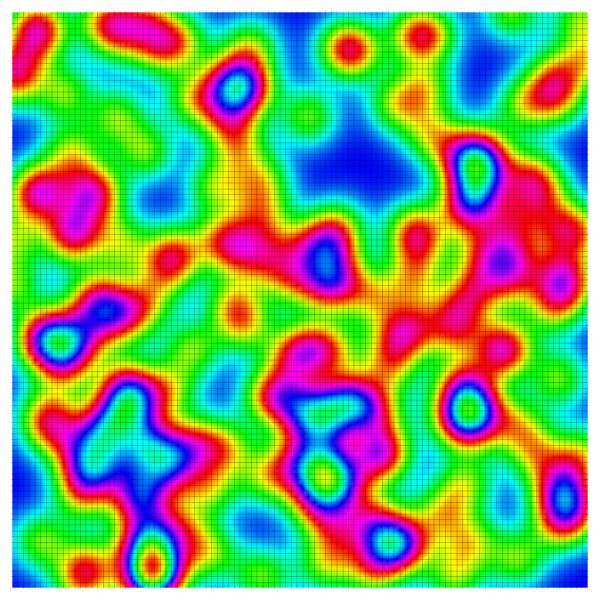A Potential Rosetta Stone of High Temperature Superconductivity

Image courtesy of N. J. Curro (UC Davis) and Los Alamos National Laboratory Numerical simulation of the magnetic inhomogeneity (red = magnetism, blue = superconductivity) caused by replacing 1% of the indium atoms in a superconductor (CeCoIn5) with cadmium atoms. The field of view is approximately 100 nanometers along each edge. (Cover Image from Seo et al., Nature Physics, 10, February 2014).
The Science
High purity single crystals of superconducting material (CeCoIn5) with the highest observed superconducting temperature for a cerium-based material enabled investigation of the relationship among magnetism, superconductivity, and disorder by strategic substitution of certain atoms with others (dopants) in the superconductor.
The Impact
Just as the Rosetta Stone has the same message written in three different scripts giving scholars key insights into ancient languages, the subject material (CeCoIn5), by virtue of its high purity, allows study of the interplay between magnetism, superconductivity, and disorder in three different classes of unconventional superconductors (cuprates, pnictides, and heavy fermions). The versatile model system could help researchers decipher the complex emergent phenomena in different classes of unconventional superconductors and in the development of a complete theory for the high-temperature superconductivity.
Summary
Superconductivity enables the flow of electricity without any loss of energy, but this extremely low temperature phenomenon disappears above a critical temperature (Tc). Since the discovery of a new class of materials in 1986, known as unconventional superconductors, that preserves superconductivity at temperatures much higher than previously known conventional superconductors, the scientific community has been on the quest to learn about the complete mechanisms for the unconventional superconductivity to enable the design of superconducting materials that operate near room temperature.
In general, materials discovery for higher Tc superconductors has been pursued by controlled doping (strategic replacement of certain elements with others) of a starting material with an already high Tc. Although this approach seems to work to certain extent, predicting the superconducting behavior of newly synthesized materials remains a major challenge due to several complexities including the disorder in the crystalline materials.
An international team led by scientists at Los Alamos National Laboratory has demonstrated that the compound CeCoIn5 with incredibly high purity and the highest superconducting temperature for a cerium-based material could serve as an ideal system to investigate the effect of disorder in the materials. Magnetic fluctuations, a driver for unconventional superconductivity, are indeed observed in pristine CeCoIn5, but locally disappear in the material doped with a small amount of cadmium (replacing indium). Surprisingly, the superconducting transition temperature of the doped material remained nearly unaffected.
This work shows that static 'droplets' of magnetism form around the doped atoms, but they do not impact the superconductivity in this material. It is expected that further research on this material will enable deciphering of other aspects of unconventional superconductivity that could pave the way to the development of a more complete theory for this complex emergent phenomenon.
Funding
DOE Office of Science, Basic Energy Sciences program. International support for co-authors was provided by Canada, France, Switzerland, Korea, and China.
Publications
S. Seo, X. Lu, J.-X. Zhu, R. R. Urbano, N. Curro, E. D. Bauer, V. A. Sidorov, T. Park, Z. Fisk, and J. D. Thompson, “Disorder in quantum critical superconductors.” Nature Physics 10, 120 (2014).
S. Gerber, M. Bartkowiak, J.L. Gavilano, E. Ressouche, N. Egetenmeyer, C. Niedermayer, A.D. Bianchi, R. Movshovich, E.D. Bauer, J.D. Thompson, and M. Kenzelmann, “Switching of magnetic domains reveals spatially inhomogeneous superconductivity.” Nature Physics 10, 126-129 (2014).
Contact Information
Kristin Manke
kristin.manke@science.doe.gov
Media Contact
More Information:
http://www.science.doe.govAll latest news from the category: Physics and Astronomy
This area deals with the fundamental laws and building blocks of nature and how they interact, the properties and the behavior of matter, and research into space and time and their structures.
innovations-report provides in-depth reports and articles on subjects such as astrophysics, laser technologies, nuclear, quantum, particle and solid-state physics, nanotechnologies, planetary research and findings (Mars, Venus) and developments related to the Hubble Telescope.
Newest articles

Decoding Cancer: 40 Years of Breakthroughs in Genetic Research
Cancer in children and adolescents is rare. Nevertheless, malignant diseases are still one of the most common causes of death in this age group. Survivors of childhood or adolescent cancer…

Let’s Think Before the First Drink: How Early Substance Use Might Lead to Brain Structure Differences Among Adolescents
Many differences appeared to exist prior to any substance use, pointing to the role brain structure may play in substance use risk, NIH-supported study suggests. Studies reveal factors that expose…

Combating Kidney Cancer Using Enhanced Immunotherapies
Medical University of South Carolina Hollings Cancer Center researcher receives Department of Defense Early Career Scholar Award to improve immune therapies by targeting resistant kidney tumors. A Medical University of…



